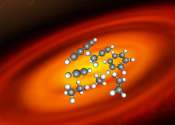Very Large Telescope detects first superstorm on exoplanet (w/ Video)
Astronomers have measured a superstorm for the first time in the atmosphere of an exoplanet, the well-studied "hot Jupiter" HD209458b. The very high-precision observations of carbon monoxide gas show that it is streaming ...









